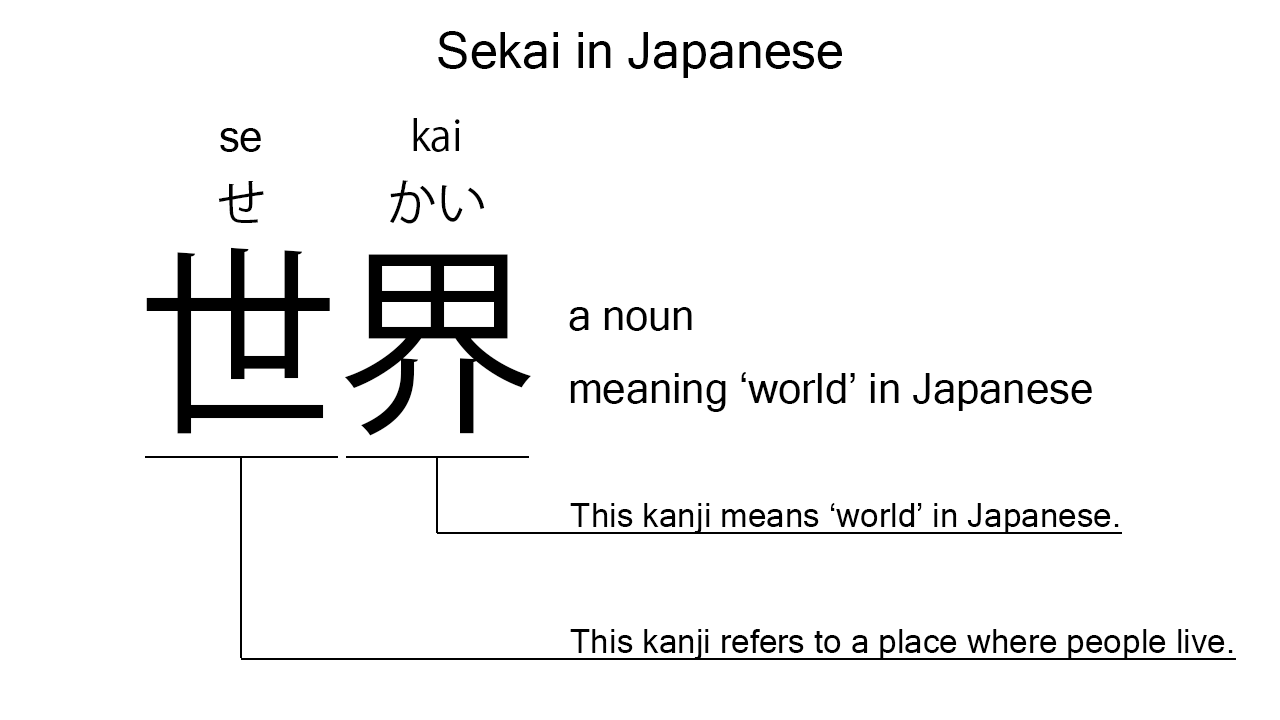What does “sekai” mean in Japanese?
Native speakers say “sekai” to mean ‘world’ in Japanese. Perhaps, some Japanese learners know this word as it is sometimes used in Japanese movies, songs, novels, manga, anime, and the like. In this blog post, however, I will explain it in detail based on its kanji expression. And also, I will explain how to use it through example sentences. My explanations would help Japanese learners to understand “sekai” more clearly. Then, let’s get started!
Contents
Definition and meaning of “sekai”
Let me start with the definition and meaning of “sekai”.
- sekai – 世界 (せかい) : a noun meaning ‘world’ in Japanese.
Normally, Japanese native speakers use this noun to refer to the place where they live, or perhaps I should say, the place where we all live.
The definition and meaning are simple and clear, I think. To understand this noun more clearly, however, let me explain its kanji characters in detail, one by one.
Sekai in kanji
The kanji expression of “sekai” consists of the following two kanji characters:
- 世 : a kanji character used to refer to a place where people live.
- 界 : a kanji character used to mean ‘world’, ‘society’, or ‘community’ in Japanese.
These two kanji characters tell us that the formed noun literally means the ‘world where we live’ in Japanese. This literal interpretation seems to be completely in line with the actual meaning.
The second kanji character is often used in Buddhism to refer to the spiritual stages. To tell the truth, “sekai” itself originally came from the religion. Japanese people in the past used it to refer to the religious place where they were living. Today, it just works as a noun to refer to the place we all are living.

When we meet new kanji expressions, we should check their kanji characters in detail to understand their meanings clearly and deeply. In many cases, kanji characters tell us a lot about the meanings of the expressions they form. Actually, here, we could get the better understanding of “sekai” through the detailed kanji check above.
So far, I’ve explained the definition and meaning of “sekai” together with its kanji expression. Then, let me explain how to use it through the example sentences below.
Example #1: how to say “world” in Japanese
kono sekai wa totemo utsukushii – この世界はとても美しい (このせかいはとてもうつくしい)
This world is very beautiful.
Below are the new words used in the example sentence.
- kono – この : a determiner used before a noun which refers to a thing close to the speaker. In the example, this is used before “sekai” to say “this world” in Japanese.
- wa – は : a binding particle working as a case marker or topic marker. In the example, this works after “kono sekai” to make the subject in the sentence.
- totemo – とても : an adverb of degree meaning ‘very’, ‘much’, ‘so’, or such in Japanese. In the example, this works before “utsukushii” to emphasize its meaning.
- utsukushii – 美しい (うつくしい) : an i-adjective meaning ‘beautiful’ in Japanese.
This is a typical usage of “sekai”. In this example, it works together with the determiner to say “this world” in Japanese. When we want to say “world” in Japanese, anyway, this noun is always a very good option.
Example #2: another usage of “sekai”
watashi wa kono utsukushii sekai ga suki desu – 私はこの美しい世界が好きです (わたしはこのうつくしいせかいがすきです)
I love this beautiful world.
Below are the new words used in the example sentence.
- watashi – 私 (わたし) : a pronoun meaning ‘I’ in Japanese.
- ga – が : a case particle used to make the subject word or the object word in a sentence. In the example, this is used after “kono utsukushii sekai” to make the object in the sentence.
- suki – 好き (すき) : the stem part of the na-adjective, “sukina”, which means ‘favorite’ in Japanese. Native speakers, however, often use this as an individual word to mean ‘to like’ or ‘to love’. In the example, actually, this is used to mean ‘to love’ in Japanese.
- desu – です : an auxiliary verb used after a noun or adjective to make it polite. Probably, this is well known as a part of Japanese desu form. In the example, this is used after “suki” to make it sound polite.
This is another typical usage of “sekai”. In this example, it works as a part of the noun phrase, “kono utsukushii sekai”, which means ‘this beautiful world’ in Japanese.
Summary
In this blog post, I’ve explained the definition and meaning of “sekai” in detail based on its kanji expression. And also, I’ve explained how to use it through the example sentences. Let me summarize them as follows.
- sekai – 世界 (せかい) : a noun meaning ‘world’ in Japanese. Normally, Japanese native speakers use this noun to refer to the place where they live, or perhaps I should say, the place where we all live. These two kanji characters literally mean the ‘world where we live’ in Japanese. This literal interpretation seems to be completely in line with the actual meaning.
Hope my explanations are understandable and helpful for Japanese learners.
Leave a Reply